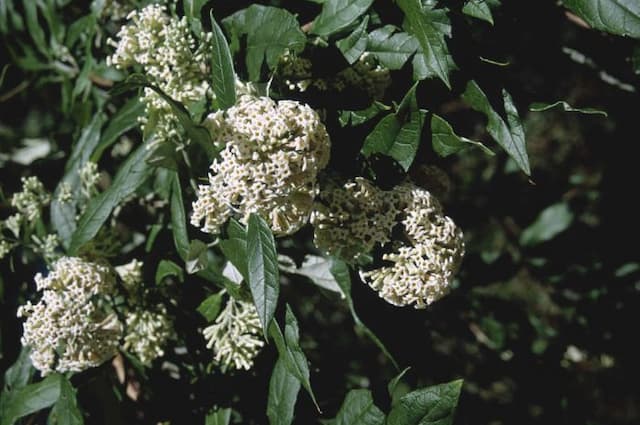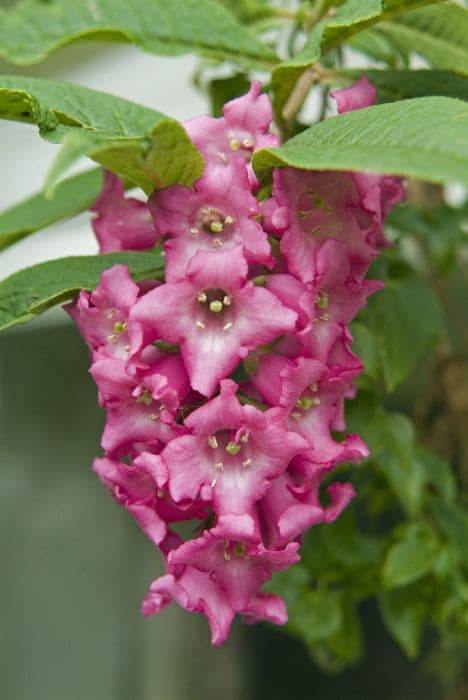Butterfly Bush Buddleja davidii 'île de France'

ABOUT
The Buddleja davidii 'île de France', commonly known as the Butterfly Bush, is an ornamental plant known for its attractive and bountiful flowers. This variety bears long, cone-shaped clusters of tiny blossoms which can range in color from rich purple to a deep magenta, adding a vibrant splash of color to the garden. Each individual flower is tiny and tubular with four petals that give it a delicate appearance. The clusters are profuse and create a commanding display when in full bloom. The leaves of the Butterfly Bush are slender and pointed, typically arranged in an opposite fashion along the stems. They are a gray-green color that can sometimes look slightly silvery, especially in full sunlight. The foliage provides a subtle backdrop that allows the vivid flower clusters to stand out. The overall form of the Butterfly Bush is somewhat arching, with branches that reach outwards and bear flowers at their tips, creating a flowing and fountain-like effect. The flowering period is usually in the summer months, and during this time, the plant becomes a hub of activity for pollinators such as butterflies, hummingbirds, and bees, which are drawn to the nectar-rich blossoms. The fragrance from the flowers is often described as sweet and honey-like, contributing to the plant's allure. While in bloom, the Butterfly Bush is a striking feature in the landscape due to its vibrant flowering clusters and attractive foliage, offering a picturesque view and a feast for visiting pollinators.
About this plant
 Names
NamesFamily
Scrophulariaceae.
Synonyms
Butterfly Bush, Summer Lilac, Orange Eye.
Common names
Buddleja davidii 'Ile de France'.
 Toxicity
ToxicityTo humans
The plant commonly known as Butterfly Bush (Buddleja davidii) is not widely recognized as toxic to humans. There are no well-documented cases of poisoning from consuming or coming into contact with this plant. However, as with many plants, it is always advisable to avoid consuming parts of decorative plants due to potential individual allergic reactions or unknown toxicities.
To pets
Butterfly Bush is also not generally known to be toxic to pets. Most animals would not normally be attracted to the Butterfly Bush, and there are no significant reports of pet poisoning from this plant. As with humans, pets should not be encouraged to nibble on this or any garden plant, as they may have plant-specific sensitivities or allergies. Always monitor pets in gardens and discourage them from eating plants to avoid any potential issues.
 Characteristics
CharacteristicsLife cycle
Perennials
Foliage type
Deciduous
Color of leaves
Green
Flower color
Purple
Height
6-8 feet (1.8-2.4 meters)
Spread
4-6 feet (1.2-1.8 meters)
Plant type
Shrub
Hardiness zones
5-9
Native area
China
Benefits
 General Benefits
General Benefits- Attracts Wildlife: Buddleja davidii 'île de France', commonly known as Butterfly Bush, is highly attractive to butterflies, bees, and other beneficial pollinators.
- Drought Tolerant: Once established, it is relatively tolerant of drought, making it suitable for xeriscaping or low-water gardens.
- Low Maintenance: This cultivar of Butterfly Bush requires minimal maintenance other than occasional pruning to maintain its shape and encourage blooming.
- Fast Growth: It has a rapid growth rate, allowing for quick establishment and filling in garden spaces.
- Long Blooming Period: The Butterfly Bush typically has a long flowering period from midsummer to autumn, providing extended seasonal interest.
- Privacy: Its dense growth habit makes it a good choice for creating privacy screens or hedges.
- Visual Interest: With its vibrant purple flowers, Buddleja davidii 'île de France' adds striking color and texture to garden landscapes.
- Versatility: It can be planted in mixed borders, foundation plantings, or as a standalone specimen, offering great versatility in garden design.
- Soil Adaptability: Butterfly Bush is adaptable to a wide range of soil types, though it prefers well-draining soil.
 Medical Properties
Medical PropertiesThis plant is not used for medical purposes.
 Air-purifying Qualities
Air-purifying QualitiesThis plant is not specifically known for air purifying qualities.
 Other Uses
Other Uses- Buddleja davidii 'île de France', or the butterfly bush, can be used in the creation of eco-friendly dyes due to the pigments present in its flowers.
- The wood of the butterfly bush is sometimes used in small woodworking projects since the branches can be quite sturdy.
- Leaves from the butterfly bush can be used in compost as a source of green material that decomposes to enrich soil.
- The butterfly bush can be incorporated into landscape design for erosion control thanks to its extensive root system.
- Its flowers can be used as natural confetti for outdoor celebrations, as they are biodegradable and non-toxic.
- The butterfly bush is sometimes planted in noise pollution reduction efforts because dense shrubbery can help absorb sound.
- Trimmed branches from butterfly bushes can be arranged into decorative indoor bouquets that hold their shape even after drying.
- Butterfly bush can be used as a living fence or natural privacy screen due to its fast growth and dense foliage.
- The dried seed heads of Buddleja davidii 'île de France' can be used in the art of dry flower arrangement or for educational seed dispersal demonstrations.
- You can create a natural bird feeding station by leaving seed heads on the plant, attracting birds that feed on them in the winter months.
Interesting Facts
 Feng Shui
Feng ShuiButterfly Bush is not used in Feng Shui practice.
 Zodiac Sign Compitability
Zodiac Sign CompitabilityButterfly Bush is not used in astrology practice.
 Plant Symbolism
Plant Symbolism- Regeneration: The Buddleja davidii, commonly known as the Butterfly Bush, is known for its ability to quickly regrow after being cut back, symbolizing resilience and the ability to recover from challenges.
- Attraction: Recognized for attracting butterflies, the Butterfly Bush is often associated with magnetism and the ability to draw in positive influences or people.
- Transformation: As the name suggests, its allure to butterflies—a creature symbolizing metamorphosis—links the Butterfly Bush to themes of change and transformation.
- Hope: The prolific flowering of the Butterfly Bush, even in poor soil conditions, sends a powerful message of hope and finding joy in hard circumstances.
- Beauty: With its long, showy spikes of flowers that bloom from summer to autumn, the Butterfly Bush symbolizes the appreciation of beauty and bringing beauty into one's life.
- Celebration of Life: The plant's vitality and role in supporting pollinators like butterflies and bees make it representative of the celebration of life and biodiversity.
 Water
WaterThe Butterfly Bush (Buddleja davidii 'île de France') should be watered deeply once a week, ensuring that the soil becomes moist but not waterlogged. During hot and dry periods, increase watering to twice per week. When watering, apply approximately one gallon of water per plant each time, directing the water to the base of the plant to avoid wetting the foliage. In case of rainfall, adjust your watering schedule accordingly to prevent over-watering. It's essential to maintain consistent moisture during the first growing season to establish a deep root system.
 Light
LightButterfly Bush thrives in full sun conditions, meaning it requires at least 6 to 8 hours of direct sunlight daily. The best spot for the plant is in a bright and sunny part of your garden, away from shaded areas. Avoid placing it where buildings or other plants could cast shade on it for much of the day, as this could affect its flowering and growth.
 Temperature
TemperatureThe Butterfly Bush prefers temperate climates and can endure temperatures as low as -20°F once established, though it does best when it's not exposed to extreme prolonged freezing. The ideal temperature range for this plant would be between 60°F to 85°F. It is a resilient shrub that can survive up to 100°F but requires sufficient watering during these hot spells.
 Pruning
PruningPrune the Butterfly Bush in late winter or early spring before new growth begins to remove dead or damaged branches and to promote a better shape and more prolific flowering. Pruning can be done down to about one-third of the plant's size as it blooms on new wood. On an annual basis, thin out no more than one-third of the oldest stems to allow light and air into the plant and encourage new growth.
 Cleaning
CleaningAs needed
 Soil
SoilButterfly Bush prefers well-draining soil with a pH of 6.0 to 7.0. A mix of loam, peat, and sand is ideal, ensuring adequate drainage and fertility for healthy growth.
 Repotting
RepottingButterfly Bushes do not often require repotting as they are generally grown outdoors. In pots, young plants may need repotting every 1-2 years.
 Humidity & Misting
Humidity & MistingButterfly Bush is tolerant of a wide range of humidity levels and does not require any specific humidity conditions to thrive.
 Suitable locations
Suitable locationsIndoor
Grow Butterfly Bush indoors with bright light, minimal water.
Outdoor
Plant Butterfly Bush in full sun, ensure well-drained soil.
Hardiness zone
5-9 USDA
 Life cycle
Life cycleBuddleja davidii 'Ile de France', commonly known as the Butterfly Bush, begins its life cycle with germination, which occurs when its seeds, dispersed by wind or wildlife, find suitable well-drained soil and warmth to sprout. Following germination, the seedling stage involves the growth of roots and shoots as the plant begins to establish itself. As it enters the vegetative stage, leaves proliferate, stems thicken, and the plant undergoes rapid growth, preparing to support flowers. With the onset of the flowering stage, typically in mid-summer to early autumn, it develops dense panicles of deep purple flowers that attract pollinators such as butterflies and bees. After pollination, the flowers give way to seed capsules, which mature, dry out, and release seeds to start the next generation. In winter, the Butterfly Bush enters a period of dormancy, where growth ceases and the plant conserves energy until conditions become favorable again in spring.
 Propogation
PropogationPropogation time
Spring-Early Summer
The most popular method of propagating the Butterfly Bush, specifically the Buddleja davidii 'île de France', is through semi-hardwood cuttings. This technique is typically carried out in the summer after flowering when the plant's new growth has started to mature and harden slightly. To do this, a gardener would cut a piece of stem approximately 4 to 6 inches (about 10 to 15 cm) long, ensuring that a few leaves are left at the top. The lower leaves are removed, and the cut end is dipped in rooting hormone to encourage root development. The cutting is then placed in a well-draining potting mix and kept in a warm, humid environment until roots have formed, which may take several weeks. Once rooted, the cutting can be transplanted into a suitable location in the garden. By following this method, new Buddleja davidii 'île de France' plants will be clones of the parent, maintaining the same desirable characteristics.

![Butterfly bush [Berries and Cream]](/_next/image?url=https%3A%2F%2Fplants-admin.emdemapps.com%2Fimages%2Fplants%2F%2Fimages%2F604b650f667be.png&w=640&q=75)




![Butterfly bush [Nanho Purple]](/_next/image?url=https%3A%2F%2Fplants-admin.emdemapps.com%2Fimages%2Fplants%2F%2Fimages%2F604b5e3cb2c58.png&w=640&q=75)

